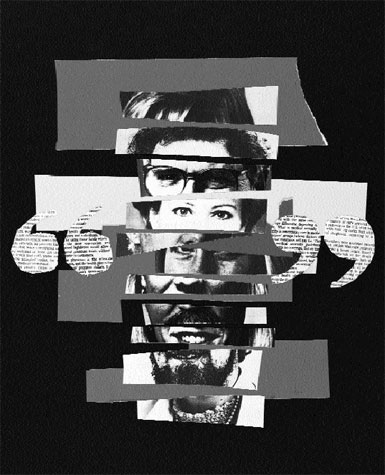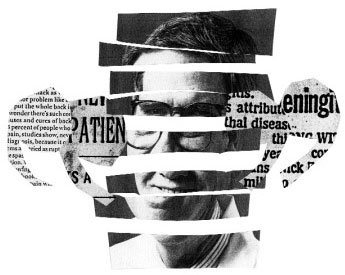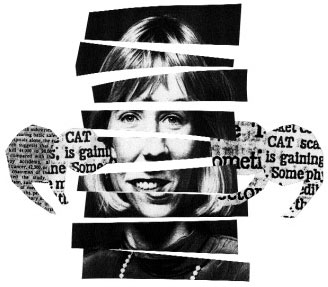Desperately seeking soundbites
By Laura Stephenson Carter
The mainstream media— print and broadcast—is a major source of health information. How do, and should, physicians and researchers communicate their work to the public? And what can, and can't, readers expect from the popular press's coverage of medicine and biomedical science?
Illustrations by Douglas and Susan Harp
Joyce DeLeo, Ph.D., was eager to talk to the media about her research on neuropathic pain—a kind of intense, long-lasting pain caused by damaged nerves. Flattered that the American Association for the Advancement of Science had invited her to participate in a press conference at the group's 1998 annual meeting, she had a news release prepared by the Dartmouth Public Affairs Office and got briefed on how to handle questions that might come up about the use of animals in her research. But DeLeo, an associate professor of anesthesiology, never expected that the media coverage would get so out of hand that she would be deluged with letters from desperate people begging her for help.

|
The headlines that appeared in hundreds of newspapers worldwide screamed: "Chronic pain relief on way, scientists say: Agony that is unrelieved even by morphine can now be treated with cytokine blockers" (Toronto Globe and Mail), "New drugs may bring relief from neuropathic pain" (Cleveland Plain Dealer), "Optimism over neuropathic pain treatment" (London Financial Times), and "Cancer pain advance made: Research suggests that the intractable pain is caused by an overproduction of a protein that promotes healing, and drugs blocking them may bring relief " (Associated Press). [See ERRATUM note below.]
At the press conference, DeLeo had described a new understanding of how the nervous and immune systems interact and had suggested that cytokines, which are produced by the immune system to help the body heal injuries, might also cause neuropathic pain. Reporters swarmed around her afterwards, demanding to know when her findings would lead to new pain-relieving drugs. "I said very emphatically at the time that what we're doing is basic science research, that I had no idea how long it would be to have this work translated into the clinic."
Yet within a couple of weeks, DeLeo recalls, "I started getting bombarded by letters, e-mails, phone calls." She pulls out a thick folder stuffed with letters from desperate patients. "I guess what bothered me most about my experience was that the letters that I got from patients—oh, they're just agonizing." She selects one letter from the folder and reads: "I heard from the article in the San Antonio Express News that you found a cure. How can I get these drugs?" Another couple drove all the way from Alabama to see her, and DeLeo had to explain to them that she was a researcher and didn't see patients. "The media really did an injustice," she says, "not only to our work, but to give such hope for these people who are in chronic pain."
DeLeo was so upset by the experience that she refused to talk to the media about her research after that. Yet she knows that few people would have paid attention to her work if the news reports had merely said, "Researchers have found cytokines increased in the spinal cord response to nerve injury." She sighs, "Who'd care?"
Plenty of people do care about medical science, and they count on the media being able to put complicated research results into plain English. While the media can be overzealous—sometimes even raising false hopes, as in the case of DeLeo's research—more often than not they do a good job of translating medical information, presenting a balanced view, and providing people with news they can use.
So how can the media manage to liven up what would otherwise be considered dull and technical medical science without exaggerating or sensationalizing the information?
"I think the primary challenge is conveying the absolute truth of a new medical finding in as accurate a way as possible, without hype and without suggesting that we know all the answers," says Susan Dentzer, the health-care correspondent for the NewsHour with Jim Lehrer as well as a 1977 Dartmouth College graduate and a DMS Overseer.
Medical developments are usually reported first in journals that can be a challenge even for physicians in other fields to understand. "What would really help is if the articles in the medical journals were better written in the first place—in plain English," says Dentzer. Even if just the abstract was written clearly, was expanded from one to several paragraphs, and put the research in context, "journalists would then be able to draw on that first wave of information," she says.
Instead, the media counts on being able to talk with health-care professionals who are willing to explain what's in the journals or the relevance of what's being reported by organizations like the Centers for Disease Control (CDC) and the Institute of Medicine (IOM). A number of physicians and medical researchers at DMS feel an obligation to keep the public—including other members of the health-care profession and policy-makers, as well as lay audiences—informed about medical developments. "One of the precepts of our profession is to educate the public about health-related matters," says Harold Sox, M.D., chair of the Department of Medicine and former president of the American College of Physicians. "That's one of the best ways we can extend our message about good health behaviors beyond the confines of the exam room."

|
|
"I think the primary challenge is conveying the absolute truth of a new medical finding in as accurate a way as possible, without hype and without suggesting that we know all the answers," says journalist Susan Dentzer, a DMS Overseer. |
Sox, who also chairs the U.S. Preventive Services Task Force, is asked frequently by the media to "comment on new developments, particularly in the prevention area." He likes being able to reach millions of people at once. "If you're going to go on the Today Show or something like that, what you have to remember is that there are 10 million people out there listening to you," he says. The media has interviewed Sox about many task force reports, some of them controversial—such as a proposal to start cholesterol screening later than some experts recommended, a recommendation against routine prostate screening, and advice that doctors do fewer diagnostic tests and spend more time talking to patients about ways to stay healthy.
Infectious disease expert John Modlin, M.D., who chairs the national Advisory Committee on Immunization Practices for the CDC, is interviewed often on vaccine safety issues. "I think there's a real obligation, on the part of myself and other members of our committee, to convey what is fortunately mostly good news," he says. "We're dealing with immunizations and immunization programs where vaccines that we discuss and work with, evaluate, and ultimately recommend can and do prevent tremendous amounts of disease and are extraordinarily beneficial to society."
Surprisingly, physicians often hear first about medical advances through news reports rather than through professional channels and may even contact a doctor they've seen quoted in the public press in order to get clarification on a healthrelated issue. DMS faculty who've been featured in the media say they routinely get called by other physicians who have questions.
"The general press gets a lot more exposure than the medical subculture does," points out neurologist H. Gilbert Welch, M.D., M.P.H., a professor of medicine. "Not many physicians regularly read academic journals. So if you have something that you want to communicate, you certainly need to be communicating with people in the general press."
Elected officials and other policy-makers rely on the media for much of their information, too. "Ultimately, health care gets established by political bodies, and political bodies read the newspaper, they listen to the radio, they hear what's going on with their constituencies," says Diane Harper, M.D., an associate professor of ob-gyn. Her research is related to the prevention of breast and cervical cancer in women, and she has headed programs in New Hampshire and in Missouri. "It was very important to get out the message that these were annual screens that women needed to have done."
"The main thing that talking to the media gets you is impact," says James Sargent, M.D., a pediatrician at Children's Hospital at Dartmouth as well as a researcher at DHMC's Norris Cotton Cancer Center. A study he did linking the incidence of underage smoking to the wearing of clothing bearing tobacco logos got widespread media attention a couple of years ago and led to some changes in public policy. "I think that research was one of the main reasons there was general agreement among all the parties that cigarette companies in this country wouldn't be allowed to market those kinds of products through the mail," Sargent says. The FDA had tried and failed to eliminate cigarette promotional items, but the press coverage of Sargent's and others' research convinced state attorneys general to work a prohibition on such marketing into their tobacco settlement agreements.
,P>But it's not enough just to recognize the value of the media in getting information out to the public. Medical professionals also need to be willing to make themselves understood. Even experienced medical and science writers need help deciphering complex medical information.Journalist Dentzer explains that physicians and scientists who talk to the press shouldn't "assume that even the most capable of us necessarily has an extensive background in the particular area of research you want to talk about. Present it in the way you would present it to a very bright person of your acquaintance who knows nothing about your particular area of research, but to whom you would want to devote the time and the energy to explaining the whole context so that they could fully understand the importance of your work."

|
|
Internist Harold Sox likes being able to reach millions of people at once. "If you're going to go on the Today Show or something like that, what you have to remember is that there are 10 million people out there listening to you," he says. |
William Black, M.D., an associate professor of radiology, is among those who work hard to avoid the use of jargon and to keep their messages simple, while providing enough background information so that their research can be put into context. "I don't know if it's from experience with teaching medical students . . . concepts that are difficult to grasp, [but] I'm very careful either in repeating things and explaining things over and over again, or just not 'going there' if I think it's not going to be understood," says Black. "Basically, I try to answer the questions as clearly as I can and recognize that the reporter has to try to communicate this to a general public, try to put it in terms that can be understood by a layperson. It's a delicate balance between giving them something that they can understand, and giving them something that's really accurate."
It also helps if physicians or researchers can make their messages memorable and tell their stories in an attention-grabbing way. Succeeding at that may mean the media won't need to do as much embellishing.
"I want to try to frame that message so that it's quotable, memorable, short, pithy, and captures the imagination," Sox says. "If I do my job right, the general public is going to hear my message in a way that is going to catch their attention."
Welch has a leg up in figuring out how to craft a memorable message—he used to be a radio news director in college. "Short, clear phrases are what will make it in the press or on the radio," he says. Having a media background means that "you understand both sides of the issue. You know something about deadlines, you know something about timing, interest, and short declarative statements," he says. "It's as if you were a Cliff Note—what is the central, take-home point that you want people to take away?"
But sometimes simplifying a message isn't sufficient. It's also important to make sure a comment can't be misinterpreted or misquoted. Ethicist Ronald M. Green, Ph.D., has learned to say things in such a way that they can't be fragmented or excerpted. Green, who is director of the Dartmouth Ethics Institute, tells the story of being asked on national television what the National Institutes of Health Human Embryo Research Panel, on which he served, had discovered about the human soul. "Now if I was in a classroom, my first response would be, 'What makes you think we can find the human soul?'" he says. But he knows that "you have to be prepared so that anything you say is acceptable in the form it will go out on that night's broadcast. I think what I replied is, 'The issue of the human soul is really important, but it's not something that a commission like ours can study. It's properly the domain of theologians and religious professionals.' I wouldn't say something like, 'No, we didn't find the human soul; we didn't look for it,' because what I'll find is that the first part of the phrase will be the one that goes out that night: 'Scientists claim . . . we can't find the human soul.'"
Perhaps the trickiest part of reporting on medical issues is understanding and interpreting statistics. "Medical terms and terminology are easy to translate," says infectious disease expert Modlin. "It's the nature of the scientific method and the nature of the statistical inference that is a little more challenging."

|
|
Statistics are especially tricky. "Medical terms are easy to translate," says infectious disease expert John Modlin. "It's the nature of the scientific method and the nature of the statistical inference that is a little more challenging." |
Welch, who is the editor of a journal titled Effective Clinical Practice, agrees. He says that the journal's staff members "devote a lot of attention to how to help communicate numbers clearly and have offered some guidance specifically for communicators." For instance, he advises colleagues that "if you're reporting a ratio measure—that's a relative risk or odds ratio—make sure the absolute event rates are displayed prominently. Ratio measures are like saying there's a threefold increase in leukemia in one town as opposed to the other. It doesn't tell you how much leukemia there is in either town. It's just a ratio," he says. "At some point, you need to be grounded in how common the event is."
Often, the media may report statistics correctly but use a poor example to make a point. "The trouble media causes in interpreting medical information is usually around their attempts to create a story with some kind of human element to it," says Sargent. "They'll have a statistic, but in the context of the new finding or the research they'll tell a vignette, and the vignette often isn't really representative of what the finding is."
For example, screening women in their 50s and 60s for breast cancer is considered effective. "Yet if you read an article on screening, it almost invariably tells the story of a 30-year-old who developed breast cancer and hadn't been screened for it," Sargent says. "It's the kind of story that grabs people, but it's not the story that really is the best example of what we need to do for breast cancer screening," he explains. "I think people tend to react more to the vignette than to the statistic and walk away from the article with the perception that young women are at high risk for breast cancer."
Given all the hazards, how have oft-quoted DMS faculty come to feel comfortable talking to the media? Some have learned through experience, some have had formal media training provided by national organizations in which they've held leadership roles, and some have been coached by the College's or DHMC's public affairs office. All of them acknowledge the importance of being prepared in order to maximize the chance that the media will convey their message properly.
"You really think about what message you want to get across," Harper says, "and you think very clearly [about] who your audience is. It very much matters whether you're speaking to a junior high school class or to politicians [as far as] what words you choose, so that it really impacts on those people. That, I think, is our responsibility—we have to do our homework before we talk to people about what's happening."
Says Sox, "My approach usually is to write out my commentary for myself and try to . . . identify two or three main messages that I want to keep coming back to, maximizing the chance that I'm going to get a quote on that main message."
In addition, says Green, anyone who talks to the media "should be prepared for the question from left field. They should be willing to try to address it."
Black agrees, saying, "I usually get called right when I'm in the middle of something, but I answer the questions as accurately as I can—of course always being aware that things may be distorted or not well understood."
But the media is out to get a story, and some reporters may adopt a confrontational attitude or ask questions in a way intended to throw an interviewee off guard. Pediatrician Judith Frank, M.D., had such an experience a few years ago. She had received a lot of media attention for a study showing that newborn babies who were discharged from the hospital after less than 48 hours had a 50% increase in risk of readmission and a 70% increase in risk of emergency room visits.
She appeared on Good Morning America, the MacNeil/Lehrer Newshour, and Dateline, and also testified before a Congressional committee about federal legislation designed to guarantee mothers and their babies a 48-hour stay after delivery. She says she didn't feel nervous—maybe thanks to her theater experience in high school and college—but she admits she was put off by the confrontational style of the Dateline reporter.

|
|
"You really think about what message you want to get across," says ob-gyn Diane Harper, "and you think very clearly [about] who your audience is. We have to do our homework before we talk to people about what's happening." |
Frank was seething inside but worked hard to remain outwardly calm. She knew better than to show her annoyance. She remembers, when she was growing up, watching her father, who chaired the board of governors of the New York Stock Exchange, keep his cool even when dealing with an often hostile media. "I kept saying things like 'Let's look at this in a different way'" Frank says. "Or 'That's not the question that you meant to ask; I'm sure you meant to ask it in this way,' You do get frustrated, because they keep asking you in a way that was somewhere between controversial and obnoxious. But I kept rephrasing the questions that they were asking me and trying to get across what I really wanted to get across." In the end, she was satisfied that the Dateline story was just as balanced as the other stories.
While media-savvy physicians and researchers may respect journalists, they don't completely trust them. "Don't assume that something you say off the record will remain off the record—unless it's a journalist with whom you've developed a relationship and can trust," says Green. "Expect to be excerpted. And make sure your reasonable excerpts don't shock or confuse."
"Reporters are looking to try to make news," Sox explains. "You can't allow them to do that, and you don't make it easy on the reporter. If a reporter asks you a leading question, that all you have to do is say 'yes' [to], then you are quoted. You've got to be aware of those traps and not make it easy on them. They're going to fillet you if you make a mistake, and you don't owe them a thing."
In its effort to present a balanced story, the media is also always on the lookout for the negative as well as the positive side of an issue. But getting the negative side may not always be easy. Take cancer screening, for instance—many physicians are willing to recommend screening as a way to detect cancer early. It's harder to find someone who's willing to articulate the opposing view.
"Stories will often quite appropriately talk about the pros and cons of screening issues," says Black. "There's no problem finding a lot of people who will talk about the pros." It's more difficult for the media to find "someone who can understand and express the cons. So I usually get quoted on the con side." He adds, "It always appears that I'm against every possible screening. But it's out of context, since they don't hear me articulating the plus side."
And not only does Black get painted as the naysayer, but he's sometimes even cast as a "bad guy." Black describes a time when the Wall Street Journal and NBC were supposedly doing a joint story. The Journal reporter, a specialist in health care, "wrote what I thought was a very balanced article . . . on the pros and cons of lung cancer screening," Black explains. "If you read it, you would say 'Well, most experts are leaning away from screening.' But NBC presented a very different picture, he says. "Two days later, the NBC news had a short, 10- minute blurb [with] an entirely different message. They showed three young people who purportedly were saved by the screening technique, although there's no way to prove that. You were immediately drawn in emotionally as to why this is so great. And then they said, 'Some HMOs and physicians don't think it's a good idea,' and they panned to me for 10 seconds." The rest of Black's 30-minute interview was on the cutting room floor.
And, of course, there's always the danger that the media, in its efforts to make the news interesting, may make medical developments sound a little too exciting.

|
|
"Stories will often talk about the pros and cons of screening issues," says radiologist William Black. "I usually get quoted on the con side, so it appears that I'm against every possible screening. But they don't hear me articulating the plus side." |
"One of the biggest problems is when the media tends to exaggerate and sensationalize things," says Modlin. "A great example is a few years ago with the 'flesh-eating strep.' Using terms like that is obviously an attention-grabber, and highly sensationalist —not a very accurate description of a problem." Modlin feels it would have been better had the media described it as "an organism that can cause an infection, which can develop suddenly and spread rapidly through your skin and other soft tissues." Yet "it can," he admits, "be a life-threatening disease." He largely blames British tabloids for the more terrifying term, but says U.S. journalists were quick to use it, too.
Certain topics are especially prone to being sensationalized. "The leading contenders for that kind of stuff are any sort of dreadful or terminal disease— you know, cancer's at the top of the list," Dentzer says. "Anything where a lot of people get it and a lot of people suffer. If there's a finding that suggests to whatever degree that the suffering will be mitigated or will go away or the disease will be cured, that is a potentially tremendous basis for some misleading reporting and misleading articles."
"I think that the coverage of the medical errors story is a good example of where the media coverage was quite alarmist," Welch says. "To be fair though, they were reporting what the IOM was reporting. They just weren't as critical as they could have been and should have been."
Welch recently asked Dentzer to write an article for Effective Clinical Practice on how the medical errors story was reported—or misreported.
Dentzer explains that health correspondent Robert Bazell of NBC ignored a press embargo—a standard practice whereby news is shared with reporters who agree not to release it until a specified date. Bazell had received the IOM report outside normal channels, so saw no need to honor the embargo and broke the medical errors story before anyone else did. The rest of the national media then scrambled to report the story, too.
The story broke so fast that the media had not had enough time to read and analyze the report carefully, says Dentzer. Bazell set off a "huge panic in the press," she says. "As a consequence, I would say that not many people read through the entirety of the study. The story became '100,000 people get killed each year because of medical errors.' That was reported in such an incendiary way that it led instantly to this sense of outrage—'Oh, my God, there are all these inept providers out there doing stupid things that result in the deaths of 100,000 innocent Americans.'"
Most of the media failed to report the main conclusion of the IOM study—that health care needs to be systematically overhauled so the potential for routine, predictable human error is taken out of the system. "Lots of other industries have evolved ways of covering for people's mistakes and backstopping people's mistakes," Dentzer explains, "like, for example, the airline industry."
But, she adds, "having read through as much of the press coverage as I could get my hands on, in maybe about 10 percent or fewer of the pieces . . . did people report that this was the main conclusion of the study. The rest of it . . . made it sound like it was one big horrible case of medical malpractice rampant throughout the system."
Sox—who wrote an article on medical errors for the same issue of Effective Clinical Practice, evaluating the accuracy of the reported numbers—says, "I have found that the best media coverage of less controversial stories has been quite thoughtful." But, he adds, on an inflammatory issue like the medical errors story, the media may "spend less time on thoughtful analysis than they would if the more newsworthy content didn't distract them."

|
|
Even pain researcher Joyce DeLeo has given the media a second chance. "It's important to tell society about what we're doing in biomedical research," she admits. She was pleased by a recent feature on her work in Men's Journal. |
The medical errors saga "illustrates how the news media struggles against long odds to digest and convey the nuances of many medical stories," Dentzer concluded in her article for Effective Clinical Practice. "Then we must convey this complexity to our readers and viewers in a way that doesn't bore their socks off—and still does justice to a problem that is usually far thornier, and often less sexy, than the headlines over our stories suggest."
So while journalists try to steer a course between the doldrums of boredom and the rocky coast of sensationalism, physicians and researchers warily navigate through seas that are sometimes choppy and occasionally shark-invested but, happily, usually smooth.
"Truly the thing that I learned early on in my research career," says Diane Harper, "is that you can be a great scientist and you can do wonderful research, but if nobody knows about it and you don't know how to communicate it, it's worthless. My goal is to help educate people . . . in language that they can understand."
Even pain researcher Joyce DeLeo has given the media a second chance. "It's important to tell society about what we're doing in biomedical research," she admits. Several months after the 1998 feedingfrenzy over her work, she agreed to do an interview for Men's Journal. The resulting feature quoted her accurately and described her as one of many researchers "looking at the underlying biochemistry of pain." She was pleased.
Laura Carter is the associate editor of Dartmouth Medicine.
ERRATUM: There was an error in the article above. A headline on a newspaper story about a DMS researcher's work was identified as being by Associated Press (AP). The headline, however, was the work not of AP but of the newspaper that ran the story. We strive for accuracy in Dartmouth Medicine and regret the error.
